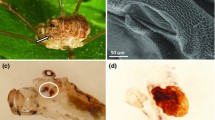Abstract
The azalea lace bug secretes a clear fluid from secretory setae on the antennae and globulated spines on the dorsal and lateral aspects of the abdomen. The secretion contains 2-alkyl-5-hydroxychromones, the corresponding chromanones and diketones, and straight-chain aldehydes and ketones.
Similar content being viewed by others
References
Cooke, R.G., andDown, J.G. 1971. Colouring matters of Australian plants. XVI. Minor constituents ofDianella revoluta andStypandra grandis.Aust. J. Chem. 24:1257–1265.
Drake, C.J. andRuhoff, F.A. 1965. Lace bugs of the world: A catalog (Hemiptera: Tingidae).Smithson. Inst. USNM Bull. 243:634 pp. 000.
Eguchi, S. 1979. Hydrogen transfer in the retro Diels-Alder fragmentation of oxygen-containing heterocyclic compounds. II. Chromones.Org. Mass Spectrom. 14:345–349.
Ellis, G.P. 1977. Chromenes, chromanones, and chromones.Heterocycl. Compd. 31:589.
Ellis, G.P. 1977b.Chem. Heterocycl. Compd. 31:222.
Ellis, G.P. 1977c.Chem. Heterocycl. Compd. 31:495–556.
Ellis, G.P. 1977d.Chem. Heterocycl. Compd. 31:256.
Johnson, C.G. 1936. The biology ofLeptobyrsa rhododendri Horvath (Hemiptera: Tingitidae), the rhododendron lace bug.Ann. Appl. Biol. 23:342–368.
Kametani, T., andKano, S. 1963. Synthesis of heterocyclic compounds. LXXX. Synthesis of papaverine derivatives. 10. Synthesis of 1-(2,3-dihydroxyphenyl)- and 1-(2,6-dihydroxyphenyl)-3-methyl-6,7-methylenedioxyisoquinoline and its related compounds.Yakugaku Zasshi 83:356–360;Chem. Abstr. 59:7572b, 1963.
Livingstone, D. 1978. On the body outgrowths and the phenomenon of “sweating” in the nymphal instars of Tingidae (Hemiptera: Heteroptera).J. Nat. Hist. 12:377–394.
Sheeley, R.D. andYonke, T.R. 1977. Biological notes on seven species of Missouri tingids (Hemiptera: Tingidae).J. Kans. Entomol. Soc. 50:342–356.
Tringali, C., andPiattelli, M. 1982. Further metabolites from the brown algaZonari tournefortii.Gazz. Chim. Ital. 112:465–468.
Van De Sande, C., andVandewalle, M. 1973. Studies in organic mass spectrometry. XIV. Investigation of electron impact induced isomerisation of 2′-hydroxy-acetophenones and chroman-4-ones.Bull. Soc. Chim. Belg. 82:775–783.
Author information
Authors and Affiliations
Rights and permissions
About this article
Cite this article
Oliver, J.E., Neal, J.W., Lusby, W.R. et al. Novel components from secretory hairs of azalea lace bugStephanitis pyrioides (Hemiptera: Tingidae). J Chem Ecol 11, 1223–1228 (1985). https://doi.org/10.1007/BF01024110
Received:
Accepted:
Issue Date:
DOI: https://doi.org/10.1007/BF01024110




